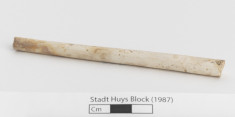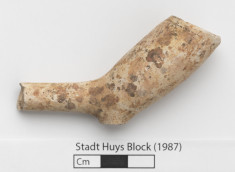Introduction: Lots 8, 9, and 15 are modern designations for adjacent parcels of land that were owned together and used as a single property until the early 1830's. Excavations produced important discoveries like that of the Colonial-era Lovelace Tavern, proving that significant archaeological resources could still exist in urban spaces. Project archaeologists were able to lobby for increased time and funds to continue their work on the strength of these finds, leading to additional discoveries. In all, the project provided considerable information about the history of New York City and its inhabitants from the 17th to the 20th centuries.
The tavern was constructed by the second English Governor of New York, Francis Lovelace, around 1670. Taverns were important spaces for colonial communities, serving as centralized meeting places that fulfilled important social, recreational, political, and economic functions. Lovelace Tavern became New York's temporary City Hall starting in the late-17th century after the Stadt Huys fell into disrepair and was demolished in 1706.
Rationale: Remains of the Lovelace Tavern were first encountered during the excavation of Test Cut AQ. Overall, archaeologists excavated 27 test cuts inside, adjacent to, or within the walls of the tavern, representing around fifty-percent of the total area. Test Cut BI was a 2- by 7-foot excavation unit that abutted the 19th-century stone boundary wall separating Lots 8 and 9. The cut is also within the interior of the 17th/18th century Lovelace Tavern. Layers from the occupation of the Tavern and its floor were discovered during excavation.
Results: The Tavern deposit in Test Cut BI was compacted, or packed down and compressed. Importantly, this suggested to archaeologists that the deposit was actually a living surface made by the constant pressing down of the dirt by human activities like walking and sitting. As such, the artifacts in this layer are of considerable importance and interest to archaeologists. Mid- to late-17th century ceramics and smoking pipe fragments were recovered from both the intact and cut parts of the deposit. The overall layer was excavated between 10.5- and 23-inches below excavation surface.
Lot 8, Test Cut BI, Stratum VIII, Level C
-
Collection method
Trowel, Wetscreen (1/2-inch mesh). Natural Level.
-
Soil description
Yellow-Brown Silt with Charcoal (and) Mortar
-
Munsell
2.5Y 5/4








